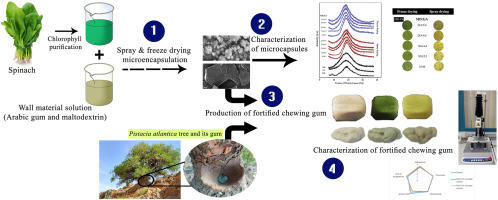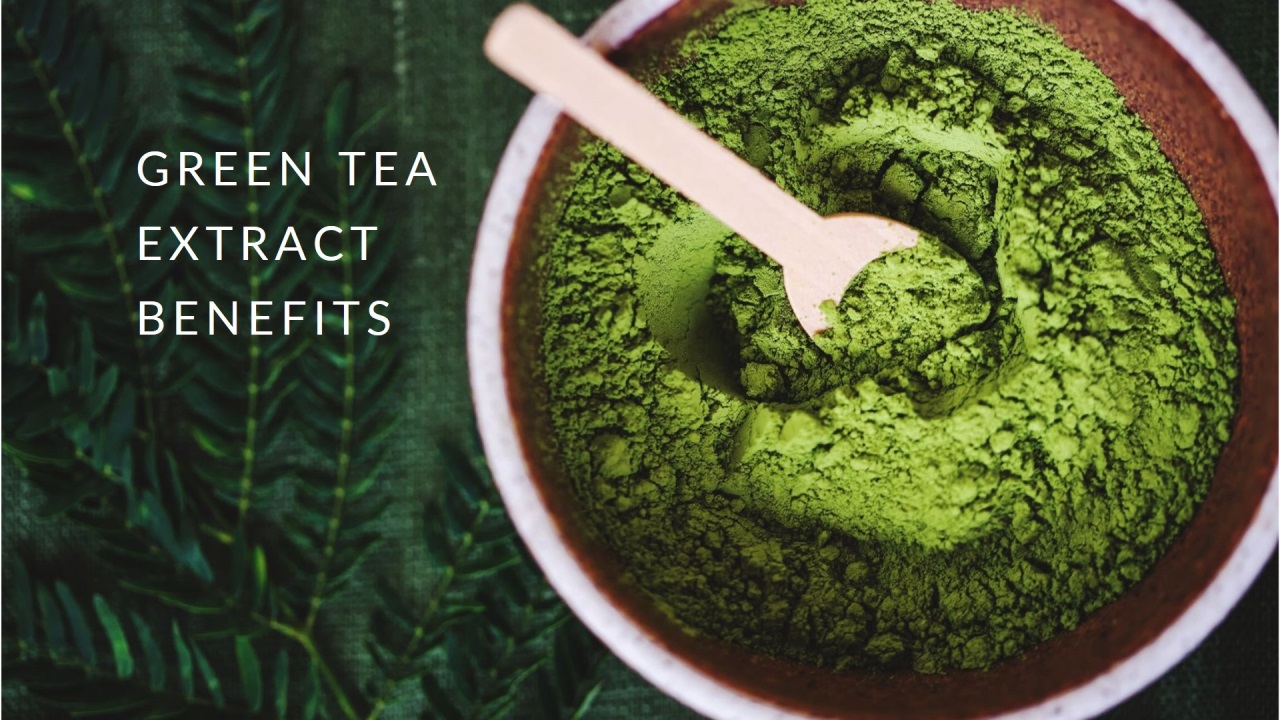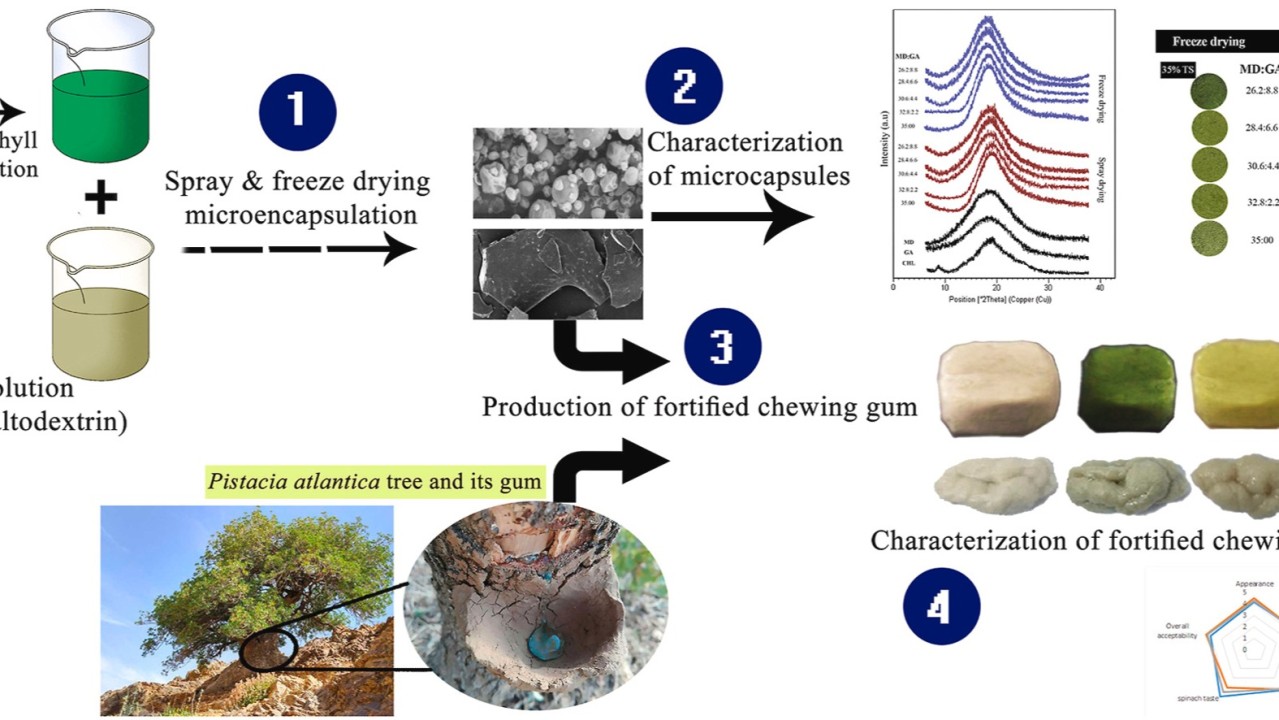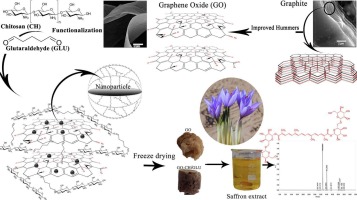Highlights
-
A natural-based chewing gum was formulated using Pistacia Atlantica gum.
-
Spinach chlorophyll was encapsulated using different carriers and drying approaches.
-
More solids and Arabic gum led to higher chlorophyll retention.
-
1% CHL microcapsules didn’t adversely affect chewing gum texture.
-
Spray-dried capsules release less chlorophyll than that from the freeze-dried one.
- a
- Incubator Center of Gorgan University of Agricultural Sciences and Natural Resources, Gorgan, Iran
- b
- Research Institute of Food Science and Technology, Mashhad, Iran
- c
- Department of Food Science and Technology, Quchan Branch, Islamic Azad University, Quchan, Iran
Received 31 August 2023, Revised 19 November 2023, Accepted 16 December 2023, Available online 17 December 2023, Version of Record 23 December 2023.
Abstract
This study aimed to extract and encapsulate spinach extract as a source of chlorophyll (CHL) through freeze- (FD) and spray-dried techniques (SD), followed by utilizing microencapsulated CHL (mCHL) in development a functional chewing gum (CG) based on Pistacia atlantica. The characteristics of mCHL underwent significant alterations through the employment of various concentrations (25 and 35% w/w) and amalgamations of Arabic gum (0–8.75 g) and maltodextrin (18.75–35 g). The mean values for powder yield and encapsulation efficiency in FD powders at 25% total solid content (TS) were 19.24% and 5.28% greater, respectively, than those of spray-dried samples, while SD microcapsules exhibited significantly enhanced storage stability. Microscopic analysis revealed the considerable impact of drying method, carrier type, concentration, and ratio on both the size and surface properties of FD- and SD-mCHL. An increase in TS from 25% to 35% resulted in a significant increase in mean particle size for SD powders from 7.19 μm to 10.96 μm. The textural analysis of CG demonstrated that the incorporation of CHL, in both free and encapsulated forms, did not negatively affect its hardness, adhesiveness, springiness, cohesiveness, chewiness, and resilience. Furthermore, the sensorial attributes of the CG samples, including appearance, spinach taste, and overall acceptability, were improved. Oral release analysis showed that after 15 min of chewing, the CHL release from CG samples was 94.5% and 70.3%, respectively, indicating that SD provided a slow release mechanism for CHL. In conclusion, both FD and SD CHL exhibited favorable technological traits and can be utilized as a delivery vehicle towards development of functional food products.
Graphical abstract
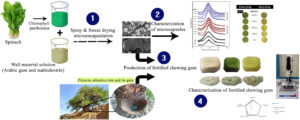
Introduction
The Baneh tree, or Pistacia atlantica subspecies kurdica, is a medicinal and food plant native to Iran. It grows wildly and is well-known for its therapeutic properties, which are derived from the bioactive compounds in its different parts (Rahman, 2018). One of the products of this tree is a gum that exhibits antioxidant, antibacterial, anti-inflammatory, and anticancer properties (Khamevar et al., 2021; Rahman, 2018). Chewing gum (CG) is a product that is familiar to almost everyone and is often bought impulsively (Caracciolo et al., 2019). Therefore, developing a CG from the Baneh tree could be beneficial. It could not only improve societal health but also reduce the negative impact of discarded synthetic gum on wildlife.
Color is a key factor in customer preferences for food products, and creating a CG necessitates the use of a natural colorant. Chlorophyll (CHL) and its natural and semi-synthetic derivatives have seen growing demand as food colorants and supplements due to their health benefits (López-Cruz, Sandoval-Contreras, & Iñiguez-Moreno, 2023). CHL has antioxidant, anti-mutagenic, and xenobiotic enzyme modulating properties, and can induce apoptosis in cancer cells (Hayes & Ferruzzi, 2020). However, its use is limited because it is unstable under environmental stressors and adverse conditions such as enzymatic reactions or acidic mediums. It also has poor water solubility (Agarry et al., 2022; Hsiao et al., 2020). Therefore, these issues need to be addressed before CHL can be used in food products.
Encapsulation is a technique that creates physical barriers around bioactive compounds to form “micro/nanocapsules”. This process can extend the shelf life of encapsulated herbal products and improve their processability, stability, delivery, cost, etc. (Deladino, Anbinder, Navarro, & Martino, 2008; Rajabi, Ghorbani, Jafari, Mahoonak, & Rajabzadeh, 2015). Spray drying (SD) and freeze drying (FD) are two encapsulation methods that use wall material to protect bioactive compounds. Gum Arabic (GA) and maltodextrin (MD) are common carriers used for encapsulation. MD has excellent water solubility and low viscosity at high concentrations but lacks emulsifying activity (Kenyon & Anderson, 1988; Schlindweinn et al., 2022). GA has good solubility and emulsification capabilities but is expensive, limited in availability, and can cause viscosity issues at high concentrations (Al-Hamayda, Abu-Jdayil, Ayash, & Tannous, 2023). Combining these two substances can balance these properties and mitigate their respective disadvantages. Studies have shown that the encapsulation efficiency of bioactive compounds was significantly higher when MD was used with GA compared to MD alone (Rajabi et al., 2015; Ravichandran et al., 2014; Sukri, Multisona, ZaidaSaputra, Mahani, & Nurhadi, 2020). Furthermore, the morphological characteristics of SD and FD powders are significantly different. The morphology of encapsulated powders can be evaluated from three distinct perspectives: the influence of TS of feed, the ratio between MD and GA, and the encapsulation methodology. These factors cause changes in the morphology of encapsulated powders in terms of size, shape, and porosity (Fu, You, Quek, Wu, & Chen, 2020; Rajabi et al., 2015; Zahran, Bat, & Şahin-Yeşilçubuk, 2022).
Some research have been carried out on the production of synthetic CG using encapsulated CHL from alga sources. For instance, Palabiyik et al. (2018) and Toker (2018) utilized spray-dried microalga biomass as a natural coloring agent in synthetic gum based CG. To our knowledge, no research has been conducted on the production of a natural-based CG containing microencapsulated CHL (mCHL) from spinach as a functional food. In recent years, the demand for functional foods with added health benefits has grown significantly. However, one area that remains largely unexplored is the production of natural-based CG using Pistacia atlantica gum as a base and spinach as a source of CHL. This research is significant as it is the first to explore this area, potentially paving the way for a new type of functional food. The development of such a product could provide consumers with an easy and enjoyable way to receive the health benefits of CHL derived from spinach. Furthermore, this research could have broader implications for the food industry by demonstrating a novel delivery system for nutrients using Pistacia atlantica gum. This could lead to the development of a range of new products, ultimately contributing to better health outcomes. The aims of this study were categorized into two stages: Initially, the CHL was extracted from spinach leaves, and we discussed the impact of the encapsulation method, the proportions, and concentrations of GA and MD on the physicochemical properties of mCHL in terms of aw, moisture content, powder yield, encapsulation efficiency, morphology, crystalline structure, and storage stability. Subsequently, we elaborated on the process of preparing a chewing gum using Pistacia atlantica gum. This gum was fortified with SD- and FD-mCHL, and the properties of the produced chewing gums were assessed in terms of CHL release profile, textural properties, and sensorial attributes.
Section snippets
Materials and methods
The Pistacia atlantica gum was obtained from the local market (Kurdistan, Iran). GA was procured from SD Fine Chemical Co. Limited (India). MD, possessing a dextrose equivalent ranging from 16.5 to 19, was obtained from Aldrich (USA). Ethanol (purity = 99%) was acquired from Merck (Germany). Xylitol (purity≥99%), sorbitol (purity>98%), and glycerol (purity≥99%) were purchased from Sigma Aldrich (Germany), Isomalt was procured from Beneo (Germany).
MC and aw
The MC of the encapsulated powders ranged from 3.96% to 6.07%, corresponding to the powders produced through SD-35MD and FD-6.25GA + 18.75MD, respectively (Table 3). Fig. 1 (A) shows the variations in MC as influenced by drying methods and TS, both of which had a significant effect on the response. In terms of TS, the MC was significantly reduced in both FD and SD-mCHL powders, a common trend that is consistent with other research (Mutukuri, Maa, Gikanga, Sakhnovsky, & Zhou, 2021; Rajabi et
Conclusion
This study evaluated the enrichment of a natural-based chewing gum with microencapsulated CHL obtained through freeze and spray drying methods, using varying concentrations and ratios of GA and MD. The results demonstrated that both freeze drying and spray drying techniques were effective in preserving CHL. An increase in the total solid content and the proportion of GA in the emulsion led to an improvement in encapsulation efficiency. Freeze drying resulted in the highest encapsulation
CRediT authorship contribution statement
Hamid Rajabi: Conceptualization, Funding acquisition, Project administration, Resources, Supervision, Writing – review & editing. Samineh Sedaghati: Formal analysis, Methodology, Validation, Writing – original draft. Ghadir Rajabzadeh: Supervision, Validation, Visualization. Ali Mohammadi Sani: Formal analysis.
Declaration of competing interest
The authors declare that they have no known competing financial interests or personal relationships that could have appeared to influence the work reported in this paper.
Acknowledgement
This work was financially supported by the Ario Rad Mehr Torshiz Co.- Mirmohannay (Project number: RD2022-ICGAU-1124).
References (71)
- A. Al-Hamayda et al.
Advances in microencapsulation techniques using Arabic gum: A comprehensive review
Industrial Crops and Products
(2023) - L.F. Ballesteros et al.
Encapsulation of antioxidant phenolic compounds extracted from spent coffee grounds by freeze-drying and spray-drying using different coating materials
Food Chemistry
(2017) - D. Bednarczyk et al.
Assembly of water-soluble chlorophyll-binding proteins with native hydrophobic chlorophylls in water-in-oil emulsions
Biochimica et Biophysica Acta (BBA) – Bioenergetics
(2015) - G. Caliskan et al.
The effects of the different drying conditions and the amounts of maltodextrin addition during spray drying of sumac extract
Food and Bioproducts Processing
(2013) - F. Caracciolo et al.
Natural versus enriched food: Evidence from a laboratory experiment with chewing gum
Food Research International
(2019) - D.W. Dadi et al.
Physical and functional properties, digestibility, and storage stability of spray-and freeze-dried microencapsulated bioactive products from Moringa stenopetala leaves extract
Industrial Crops and Products
(2020) - L. Deladino et al.
Encapsulation of natural antioxidants extracted from Ilex paraguariensis
Carbohydrate Polymers
(2008) - T.M. El-Messery et al.
The effect of spray-drying and freeze-drying on encapsulation efficiency, in vitro bioaccessibility and oxidative stability of krill oil nanoemulsion system
Food Hydrocolloids
(2020) - Z. Fang et al.
Spray drying, freeze drying and related processes for food ingredient and nutraceutical encapsulation
- S.A. Fioramonti et al.
Characterisation of freeze-dried flaxseed oil microcapsules obtained by multilayer emulsions
Powder Technology
(2017) - M.H. Grace et al.
Spray-dried and freeze-dried protein-spinach particles; effect of drying technique and protein type on the bioaccessibility of carotenoids, chlorophylls, and phenolics
Food Chemistry
(2022) - M. Hayes et al.
Update on the bioavailability and chemopreventative mechanisms of dietary chlorophyll derivatives
Nutrition Research
(2020) - C.-J. Hsiao et al.
Enhancement of the stability of chlorophyll using chlorophyll-encapsulated polycaprolactone microparticles based on droplet microfluidics
Food Chemistry
(2020) - S.M. Jafari et al.
Bioavailability and release of bioactive components from nanocapsules
- M. Jayasundera et al.
The effect of protein types and low molecular weight surfactants on spray drying of sugar-rich foods
Food Hydrocolloids
(2011) - Y.-R. Kang et al.
Characterization and storage stability of chlorophylls microencapsulated in different combination of gum Arabic and maltodextrin
Food Chemistry
(2019) - K. Kanyuck et al.
Temperature influences on network formation of low DE maltodextrin gels
Carbohydrate Polymers
(2019) - M. Karaaslan et al.
Gum Arabic/maltodextrin microencapsulation confers peroxidation stability and antimicrobial ability to pepper seed oil
Food Chemistry
(2021) - E. Karrar et al.
Effect of maltodextrin combination with gum Arabic and whey protein isolate on the microencapsulation of gurum seed oil using a spray-drying method
International Journal of Biological Macromolecules
(2021) - L.E. Kurozawa et al.
Effect of maltodextrin and gum Arabic on water sorption and glass transition temperature of spray dried chicken meat hydrolysate protein
Journal of Food Engineering
(2009) - P. Labuschagne
Impact of wall material physicochemical characteristics on the stability of encapsulated phytochemicals: A review
Food Research International
(2018) - T. Laokuldilok et al.
Effects of processing conditions on powder properties of black glutinous rice (Oryza sativa L.) bran anthocyanins produced by spray drying and freeze drying
LWT-Food Science & Technology
(2015) - F. León-Martínez et al.
Spray drying of nopal mucilage (Opuntia ficus-indica): Effects on powder properties and characterization
Carbohydrate Polymers
(2010) - W. Liu et al.
On enhancing the solubility of curcumin by microencapsulation in whey protein isolate via spray drying
Journal of Food Engineering
(2016) - T.T. Mutukuri et al.
Electrostatic spray drying for monoclonal antibody formulation
International Journal of Pharmaceutics
(2021) - D.P.S. Oberoi et al.
Effect of drying methods and maltodextrin concentration on pigment content of watermelon juice powder
Journal of Food Engineering
(2015) - J.A. Pellicer et al.
Stability of microencapsulated strawberry flavour by spray drying, freeze drying and fluid bed
Powder Technology
(2019) - H. Rajabi et al.
Retention of saffron bioactive components by spray drying encapsulation using maltodextrin, gum Arabic and gelatin as wall materials
Food Hydrocolloids
(2015) - H. Rajabi et al.
Surface-decorated graphene oxide sheets with nanoparticles of chitosan-Arabic gum for the separation of bioactive compounds: A case study for adsorption of crocin from saffron extract
International Journal of Biological Macromolecules
(2021) - H. Rajabi et al.
Preparation and characterization of 3D graphene oxide nanostructures embedded with nanocomplexes of chitosan-gum Arabic biopolymers
International Journal of Biological Macromolecules
(2020) - H. Rajabi et al.
Chitosan-gum Arabic complex nanocarriers for encapsulation of saffron bioactive components
Colloids and Surfaces A: Physicochemical and Engineering Aspects
(2019) - Y.R.R.S. Rezende et al.
Microencapsulation of extracts of bioactive compounds obtained from acerola (Malpighia emarginata DC) pulp and residue by spray and freeze drying: Chemical, morphological and chemometric characterization
Food Chemistry
(2018) - D.F. Rocha-Parra et al.
Influence of storage conditions on phenolic compounds stability, antioxidant capacity and colour of freeze-dried encapsulated red wine
Lwt
(2016) - A. Ruengdech et al.
Improving encapsulating efficiency, stability, and antioxidant activity of catechin nanoemulsion using foam mat freeze-drying: The effect of wall material types and concentrations
Lwt
(2022) - M.G. Santos et al.
Coencapsulation of xylitol and menthol by double emulsion followed by complex coacervation and microcapsule application in chewing gum
Cited by (4)
-
Nutraceutical dark chocolate: A delivery system for double-encapsulated extracts of Crocus sativus L., Rosa damascena, Melissa officinalis L., and Echium amoenum
2024, LWTCitation Excerpt :Moreover, as depicted in Fig. 2, the color of the medium surrounding the coacervates is similar to that of the corresponding herbal extract. This suggests that the herbal extract was not completely encapsulated by the coacervates (Rajabi, Sedaghati, Rajabzadeh, & Sani, 2024). For instance, as shown in Fig. 2B, the background color is a pale red due to the presence of free saffron bioactive compounds, particularly crocin.
-
Efficiency of freeze- and spray-dried microbial preparation as active dried starter culture in kombucha fermentation
2024, Journal of the Science of Food and Agriculture

